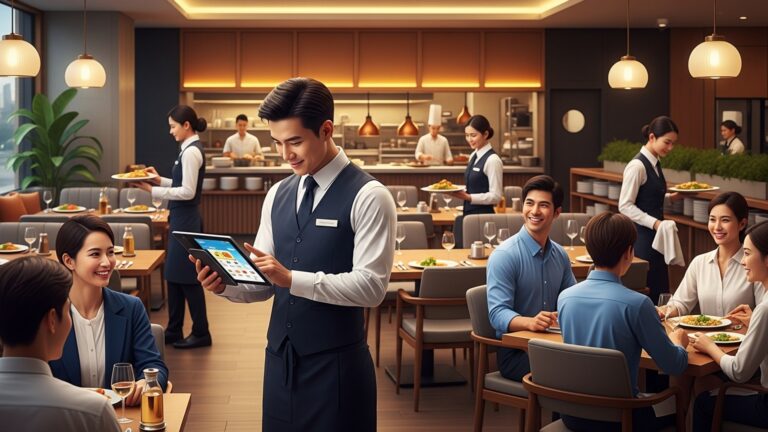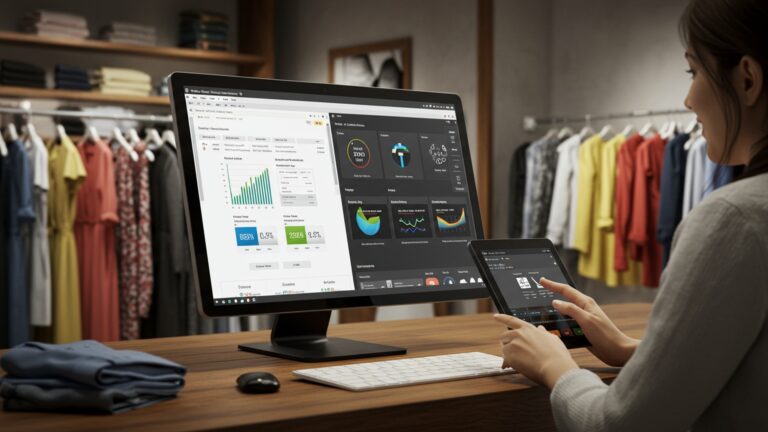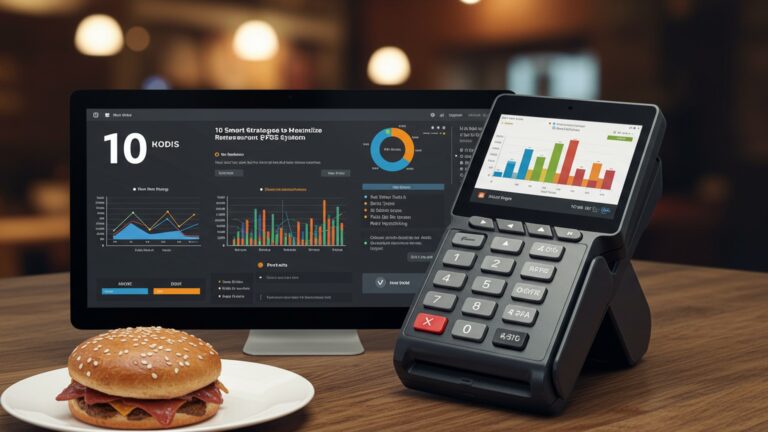Learn 7 Essential Restaurant POS Features to Improve Your Operations
In today’s fiercely competitive culinary landscape, merely serving great food no longer guarantees success; operational excellence and technological savvy are paramount. Modern restaurants navigate complex demands, from seamless online ordering and precise inventory management to personalized customer experiences. This dynamic environment elevates advanced Restaurant POS software from a simple transaction tool to the central nervous system of any thriving establishment. Understanding and leveraging its full potential is no longer optional but essential for boosting efficiency, minimizing waste. maximizing profitability. The right POS features empower operators to make data-driven decisions, streamline front-of-house and back-of-house operations. ultimately deliver an unparalleled dining experience that keeps guests returning.
1. Advanced Order Management and Kitchen Integration
At the heart of any bustling restaurant is efficient order processing. Advanced order management features within modern Restaurant POS software streamline the entire journey from customer request to kitchen execution and table delivery. This isn’t just about punching in orders; it encompasses a sophisticated suite of tools designed to minimize errors, accelerate service. enhance the dining experience.
This feature allows servers to take orders quickly and accurately, often directly from a handheld device, sending them instantly to the kitchen or bar. It includes functionalities like modifying orders with specific dietary requests (e. g. , “no onions,” “extra sauce”), splitting checks effortlessly, managing table assignments. holding orders until the appropriate course.
- Reduced Errors
- Faster Service
- Improved Table Turnover
- Enhanced Customer Experience
Digital order taking eliminates miscommunications often associated with handwritten tickets. Special requests are clearly communicated to the kitchen.
Orders reach the kitchen instantly, cutting down on lag time between a server leaving the table and the kitchen receiving the request. This can shave crucial minutes off service times, especially during peak hours.
Efficient order flow and faster service naturally lead to quicker table turnover, allowing the restaurant to serve more customers and increase revenue.
Accurate orders mean happier customers. The ability to easily split checks or accommodate special requests without delay adds to a positive dining experience.
Imagine a busy Friday night. A server takes an order for a table of six, including a vegetarian dish with no cheese and a steak cooked rare. Instead of handwriting the order and walking it to the kitchen, they input it into a tablet-based Restaurant POS software. The specific modifications are clearly displayed on the Kitchen Display System (KDS) for the chef, ensuring accuracy. When the time comes for payment, the POS system allows the server to split the bill evenly or by item with just a few taps, saving time and preventing calculation errors.
When evaluating Restaurant POS software, prioritize systems with intuitive interfaces for order entry, robust modification options. seamless integration with a Kitchen Display System (KDS). This will be the backbone of your service efficiency.
2. Integrated Inventory Management
For restaurants, managing inventory is a complex dance between minimizing waste and ensuring ingredients are always available. An integrated inventory management feature within your Restaurant POS software transforms this challenge into an opportunity for significant cost savings and operational efficiency.
This feature automatically tracks the usage of ingredients and supplies, monitors stock levels. often integrates with supplier ordering systems. It allows you to create recipes, link them to menu items. deduct ingredients in real-time as dishes are sold. It can also manage non-food items like napkins, cutlery. cleaning supplies.
- Reduced Waste and Spoilage
- Optimized Purchasing
- Cost Control
- Prevention of Stockouts
By tracking inventory accurately, you can identify slow-moving items, prevent over-ordering. reduce food waste due to spoilage.
The system can alert you when stock levels are low and even generate purchase orders based on sales data and historical trends, ensuring you only order what you need when you need it.
Precise tracking of ingredient costs helps in calculating actual food costs per dish, allowing for more accurate menu pricing and improved profit margins.
Automated alerts ensure you never run out of critical ingredients, preventing disruption to your menu offerings and potential customer disappointment.
A popular coffee shop uses its Restaurant POS software to manage its coffee bean inventory. Every time a latte is sold, the system automatically deducts the precise amount of milk and coffee beans used from the inventory count. When the milk stock drops below a predefined reorder point, the system automatically generates an alert or even an order suggestion to the supplier. This prevents the shop from running out of milk during the morning rush, saving a potential loss of sales and customer frustration.
Ensure your chosen Restaurant POS software allows for detailed recipe costing and offers automated reorder alerts. Invest time in accurately inputting your recipes and initial inventory to leverage the full power of this feature.
3. Comprehensive Reporting and Analytics
Beyond simply processing transactions, a powerful Restaurant POS software acts as an intelligent data hub, collecting invaluable insights into every facet of your business. Comprehensive reporting and analytics are crucial for making informed decisions that drive growth and profitability.
This feature gathers, organizes. presents data on sales performance, popular menu items, peak service hours, employee efficiency, inventory turns. more. Reports can often be customized, filtered by date range. visualized through charts and graphs, making complex data easy to interpret.
- Informed Decision-Making
- Identify Trends and Opportunities
- Performance Monitoring
- Optimized Staffing
Access to real-time and historical data allows owners and managers to make strategic decisions about menu adjustments, staffing levels, marketing promotions. operational improvements.
Spotting patterns in sales data can reveal popular dishes, profitable periods. opportunities for upselling or cross-selling.
Track the performance of individual menu items, promotions. even staff members, identifying areas for improvement or celebrating successes.
By understanding peak hours and sales volume, you can optimize staff scheduling, ensuring adequate coverage without over-staffing, thus controlling labor costs.
A restaurant owner notices through their Restaurant POS software‘s reports that their “Chef’s Special Pasta” is a top-seller on weekends but barely moves during weekdays. Conversely, their classic burger sells consistently well every day. This insight prompts them to offer the pasta as a limited-time weekend special, increasing its perceived value. to focus weekday specials on more universally appealing items. They also notice that Tuesday evenings are consistently slow, leading them to introduce a “Taco Tuesday” promotion to boost traffic during that specific time slot.
Regularly review your POS reports, focusing on key performance indicators (KPIs) like average check size, top-selling items. peak sales periods. Use these insights to proactively adjust your menu, promotions. staffing strategies.
4. Seamless Payment Processing
In today’s fast-paced world, customers expect quick, secure. flexible payment options. Seamless payment processing integrated directly into your Restaurant POS software is no longer a luxury but a necessity for modern dining establishments.
This feature allows the POS system to accept various payment methods, including credit cards, debit cards, mobile payments (e. g. , Apple Pay, Google Pay), contactless payments, gift cards. even split payments. Integration means the payment terminal directly communicates with the POS, eliminating manual entry and reducing errors.
- Faster Transactions
- Enhanced Security
- Reduced Errors
- Improved Customer Convenience
Integrated systems process payments much quicker than standalone terminals, reducing customer wait times and speeding up table turnover.
Modern POS systems often come with EMV compliance and tokenization, protecting sensitive customer data and reducing the risk of fraud.
Eliminating the need to manually enter amounts into a separate terminal drastically reduces human error, preventing costly mistakes and reconciliation issues.
Offering a wide range of payment options caters to customer preferences, making transactions smoother and more satisfying.
A customer at a cafe wants to pay for their order using their smartphone. The barista simply selects the “mobile payment” option on the Restaurant POS software. the customer taps their phone on the integrated terminal. The payment is processed in seconds. the transaction is automatically recorded in the POS system. For a larger group dining out, the server can easily split the bill among multiple credit cards directly through the POS, avoiding the hassle of manual calculations and separate transactions.
Opt for Restaurant POS software that offers native, integrated payment processing rather than relying on third-party integrations. This minimizes compatibility issues, streamlines reconciliation. often results in better processing rates.
5. Customer Relationship Management (CRM) & Loyalty Programs
Building a loyal customer base is paramount for long-term success in the competitive restaurant industry. Modern Restaurant POS software often extends beyond transactional functions to include powerful CRM and loyalty program features, turning one-time visitors into regular patrons.
This feature allows restaurants to collect customer data (e. g. , names, birthdays, preferences), track their purchase history. manage loyalty points or reward programs. It can also facilitate targeted marketing efforts, such as sending personalized promotions or birthday offers.
- Increased Customer Retention
- Personalized Marketing
- Enhanced Customer Experience
- Valuable Data Insights
Loyalty programs incentivize repeat visits, making customers feel valued and encouraging them to choose your establishment over competitors.
By understanding customer preferences, you can send targeted offers that resonate, leading to higher conversion rates for promotions.
Recognizing regulars and remembering their preferences (e. g. , “the usual”) adds a personal touch that significantly improves their dining experience.
CRM data can reveal demographic trends, popular times for certain customer segments. the effectiveness of different loyalty incentives.
A restaurant implements a loyalty program through its Restaurant POS software. Customers sign up at the POS, providing their email and birthday. For every $10 spent, they earn 1 point. 50 points get them a free appetizer. On a customer’s birthday, the system automatically sends an email with a voucher for a complimentary dessert. The POS system also tracks their favorite dishes, allowing servers to subtly suggest new items based on their past orders, creating a more personalized and engaging experience.
Start with a simple loyalty program (e. g. , points for purchases) and gradually expand based on customer engagement. Use the data collected through your Restaurant POS software to segment customers and create highly targeted, appealing offers.
6. Employee Management and Time Tracking
Managing staff effectively is crucial for smooth restaurant operations. it can be time-consuming and prone to errors. The employee management and time tracking features within Restaurant POS software simplify these tasks, ensuring fair treatment for staff and accurate payroll for the business.
This feature allows managers to create and manage employee schedules, track clock-in and clock-out times, calculate hours worked. manage different pay rates. It also includes permission settings, allowing owners to control what different staff roles can access or modify within the POS system.
- Streamlined Scheduling
- Accurate Payroll
- Improved Accountability
- Enhanced Security and Control
Create and distribute schedules efficiently, often allowing staff to view their shifts remotely and request time off.
Automated time tracking eliminates manual entry errors, ensuring employees are paid correctly for their hours, simplifying payroll processing.
Clock-in/out features prevent “buddy punching” and provide clear records of attendance and punctuality.
Role-based permissions prevent unauthorized access to sensitive data (like sales reports or settings) and limit actions to only what’s necessary for each role (e. g. , only managers can void orders).
A restaurant uses its Restaurant POS software for all employee management. Servers clock in and out directly on the POS terminal at the start and end of their shifts. The system automatically calculates their total hours for the pay period, factoring in breaks. The manager can then easily export these hours for payroll processing, saving hours of manual calculation. Moreover, the system ensures that only authorized managers can perform high-level functions like issuing refunds or applying discounts, maintaining financial integrity.
Utilize the scheduling and time-tracking features of your Restaurant POS software to reduce administrative burden and improve payroll accuracy. Define clear role-based permissions to maintain security and control over your operations.
7. Online Ordering and Delivery Integration
The digital age has transformed how customers interact with restaurants, with online ordering and delivery becoming non-negotiable for many. Integrated online ordering and delivery features within Restaurant POS software are essential for expanding reach and maximizing revenue in this evolving landscape.
This feature allows customers to place orders directly through the restaurant’s website or app. It also includes integrations with third-party delivery platforms (e. g. , Uber Eats, DoorDash) so that orders from these services flow directly into the restaurant’s POS system, often printing directly to the kitchen without manual re-entry.
- Expanded Reach and Revenue
- Streamlined Workflow
- Consistent Menu Management
- Improved Customer Experience
Taps into a broader customer base beyond dine-in guests, opening new revenue streams through takeout and delivery.
Eliminates the need for staff to manually re-enter online orders into the POS, reducing errors and saving valuable time during busy periods.
Manage your entire menu (dine-in, takeout, delivery) from a single platform, ensuring consistency and ease of updates.
Offers convenience to customers who prefer to order from home, enhancing accessibility and satisfaction.
A pizzeria uses a Restaurant POS software that features an integrated online ordering portal on its website. A customer places an order for a pepperoni pizza and garlic knots online. The order instantly appears on the restaurant’s POS screen and prints directly to the kitchen’s pizza station. If the restaurant also partners with a delivery app, orders placed through that app would follow the same seamless path, appearing on the POS and routing to the kitchen without staff needing to monitor multiple tablets or manually input orders.
Prioritize Restaurant POS software that offers a robust, user-friendly online ordering system and strong integrations with popular third-party delivery platforms. This will allow you to efficiently manage all order channels from a single source, maximizing efficiency and customer satisfaction.
Conclusion
Your restaurant’s POS system is far more than a simple cash register; it’s the operational heartbeat, capable of transforming challenges into opportunities. Instead of viewing the seven essential features we’ve discussed as isolated tools, consider them as interconnected gears driving your entire operation. My personal tip is to dive deep into your system’s reporting capabilities – I’ve seen countless operators unlock hidden efficiencies, like identifying peak order times to optimize staffing, simply by analyzing the data their POS already collects. In today’s dynamic market, where contactless payments and integrated online ordering are standard, an adaptable, cloud-based POS ensures you’re not just keeping pace. leading. Embrace these features not as a burden. as your strategic advantage to streamline daily tasks, enhance the guest experience. make data-driven decisions. Investing time to master these capabilities will undoubtedly lead to a more profitable, resilient. future-ready restaurant. For further insights into industry advancements, consider exploring resources like the National Restaurant Association’s technology reports.
More Articles
How to Optimize Your Restaurant’s Inventory Management
Boosting Customer Loyalty with Integrated POS Features
The Future of Contactless Payments in Restaurants
Choosing the Right POS System for Your Small Business
Understanding Restaurant Analytics: A Guide for Owners
FAQs
Why should I even bother upgrading my restaurant POS system?
Upgrading your restaurant POS is a total game-changer! It’s not just for taking payments anymore. A modern system streamlines everything from order taking and kitchen communication to inventory tracking and sales reporting, ultimately saving you time, reducing errors. boosting your bottom line.
How does a modern POS help my staff take orders faster and avoid mistakes?
Essential POS features like intuitive touch screens, customizable menus. direct kitchen printing or KDS integration mean your staff can input orders quickly and accurately. It also simplifies table management, bill splitting. modifiers, cutting down on human error and improving service speed.
Can a POS actually help me stop wasting food and save money on ingredients?
Absolutely! A good POS with robust inventory management tracks your ingredients in real-time, alerts you when stock is low. even helps identify popular dishes versus those that lead to waste. This insight helps you optimize purchasing, reduce spoilage. significantly cut down on food costs.
What kind of insights can I get from a good POS to make my restaurant better?
You’ll gain valuable insights into sales trends, peak hours, popular menu items. even staff performance. This data empowers you to make smarter decisions about staffing, menu engineering, promotions. overall business strategy, leading to improved profitability.
How can a POS help me keep my customers coming back?
Many modern POS systems offer built-in CRM and loyalty program features. They can track customer preferences, manage loyalty points. even facilitate targeted marketing campaigns like personalized offers or birthday discounts. This helps you build stronger customer relationships and encourage repeat business.
Does a POS make managing my staff easier, especially with schedules and tips?
Yes, definitely! Essential POS features often include time clock functionalities, scheduling tools. streamlined tip reporting. This simplifies payroll, helps you manage labor costs effectively. ensures fair and accurate tip distribution, making life easier for both you and your team.
Is payment processing really more secure and faster with a new POS?
Modern POS systems are designed with security in mind, offering EMV chip card processing, contactless payment options (like Apple Pay and Google Pay). robust encryption to protect sensitive customer data. They also speed up transactions, reducing checkout times and improving the customer experience.
What’s a KDS and how does it speed up kitchen operations?
A Kitchen Display System (KDS) replaces traditional paper tickets with digital screens in the kitchen. When integrated with your POS, orders instantly appear on the KDS, reducing miscommunications, improving order accuracy. allowing kitchen staff to manage tickets more efficiently. This leads to faster order fulfillment and happier customers.






